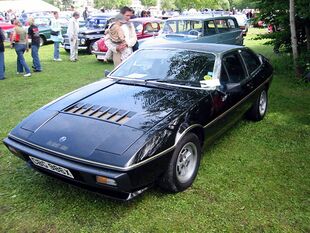Engineering:Lotus Eclat
| Lotus Eclat | |
|---|---|
 | |
| Overview | |
| Manufacturer | Lotus Cars |
| Also called | Lotus Sprint (USA)[1] |
| Production | 1975–1982 |
| Assembly | Hethel, Norfolk, England |
| Designer | Oliver Winterbottom |
| Body and chassis | |
| Class | Sports car |
| Body style | 2-door coupe |
| Layout | Front-engine, rear-wheel-drive |
| Related | Lotus Elite |
| Powertrain | |
| Engine |
|
| Transmission | 4 or 5-speed manual automatic |
| Dimensions | |
| Wheelbase | 2,438 mm (96.0 in) |
| Length | 4,458 mm (175.5 in) |
| Width | 1,816 mm (71.5 in) |
| Height | 1,194 mm (47.0 in) |
| |uk|Kerb|Curb}} weight | 1,055 kg (2,326 lb) |
| Chronology | |
| Successor | Lotus Excel |
The Lotus Eclat (Type 76 and Type 84) is a front engine rear drive coupe automobile built from 1975 to 1982 by Lotus Cars. It was based on the Lotus Elite but had a fastback body style which offered more practicality with storage in the boot (trunk), albeit with less headroom above the rear seats. The car was initially to be called the "Elite Coupe".[2] The lower half of the fibreglass bodywork was actually identical to that of the Elite.[3]
Description and history
The Eclat Series 1 (1975–1980) was announced in October 1975.[4] It used a 1973 cc 160 hp (120 kW) Lotus 907 Slant Four engine. Later cars (1980–1982) used a larger 2174 cc Lotus 912 engine, however, because of emission regulations modifications it still only produced 160 hp (120 kW). It did, however, produce more torque and thus improved the car's performance. Both were versions of the Lotus 900 series engine series, which was also used in naturally aspirated and turbo charged versions in the Lotus Esprit.
Early cars either had a four speed Ford gearbox or the five speed gearbox derived by Lotus from Austin Maxi components. Later cars used a Getrag five speed gearbox. Some cars (524) were fitted with three-speed automatic gearboxes. The Eclat had disc brakes at the front, and inboard drum brakes at the rear. Air conditioning and power steering were offered as options. The different equipments of the Series 1 cars were called 520, 521, 522, 523, and 524. The 520 has a four-speed transmission, a Ford bolt pattern, steel wheels, and smaller brakes. The remainder of the range have a 114.3 mm bolt pattern, the same disc brakes as the Elite, and GKN alloy wheels. They also received a twin exhaust and various other comfort items such as a clock and a cigar lighter. The 522 added power steering and the 523 also received air conditioning. The 524 is like the 523 but with the automatic transmission. Some other cars were also fitted with the automatic, and Lotus accommodated a variety of changes to the cars. There were also sporty versions of the 520 and 521 called the Eclat Sprint, with a black-and-white paint job, an oil cooler, and a variety of other performance upgrades.[3] Approximately 1500 examples of the Eclat were produced.[1]
Chassis
The original mild steel chassis fitted by Lotus had a strip of felt fitted between body and the steel crossmember of the chassis. In damp climates, the felt became a water trap and caused structural corrosion, resulting in a crumbling rear chassis. Chassis replacement was initially not cost effective on the Eclat and Elite, and in consequence resale values suffered. Series 2 cars were fitted with a galvanised chassis as standard and a large number of Series 1 vehicles have had replacements fitted, which are usually galvanised.
Reception
The car was well received by the motoring press, which praised the car's handling and grip.[citation needed] The fuel consumption was also considered reasonable at the time, in comparison with the larger and multi cylinder engines used in competitor GT cars.
Eclat Riviera
In 1981 Lotus introduced the Type 84, called the Lotus Eclat S 2.2 Riviera.[5] This model, which was available for two years, came with a removable roof panel, aircon, vented bonnet and rear spoiler.[1] Production totaled 223 units.
Eclat Excel
In 1982, the Eclat was developed into the Eclat Excel (later badged simply as the Lotus Excel), which used the same engine, but a modified version of the chassis, altered bodywork, and Toyota gearbox, driveline, and brakes.
Surviving cars
As at November 2017, 639 Eclats are still registered in the United Kingdom, but this figure includes all of the later Lotus Excels, which were registered as Eclats (allegedly to save the cost of a new Type Approval). About 197 of the 639 are Eclats and about 38 of these are taxed for use on public roads.[6]
Gallery
-
Picture taken in London 1980
References
- ↑ 1.0 1.1 1.2 Peter Hingston, The Enthusiasts' Guide to Buying a Classic British Sports Car, 2007, page 90
- ↑ Robson, Graham (1993). Lotus Since the 70s: Volume 1: Elite, Eclat, Excel and Elan. Motor Racing Publications. ISBN 9780947981709.
- ↑ 3.0 3.1 C. R. (June 1977). "The Lotus Eclat Sprint: Sheer exhilaration from remarkable performance and handling". Motor Sport LIII (6): 30. http://www.motorsportmagazine.com/archive/article/june-1977/30/road-impressions.
- ↑ Lotus Eclat at Earls Court today. The Times, Wednesday, 15 October 1975; pg. 4; Issue 59527
- ↑ "Lotus Eclat". www.lotusdriversguide.com. http://www.lotusdriversguide.com/Genealogy/Eclat.php.
- ↑ "Lotus Eclat". https://www.howmanyleft.co.uk/vehicle/lotus_eclat. Retrieved 14 November 2017.


